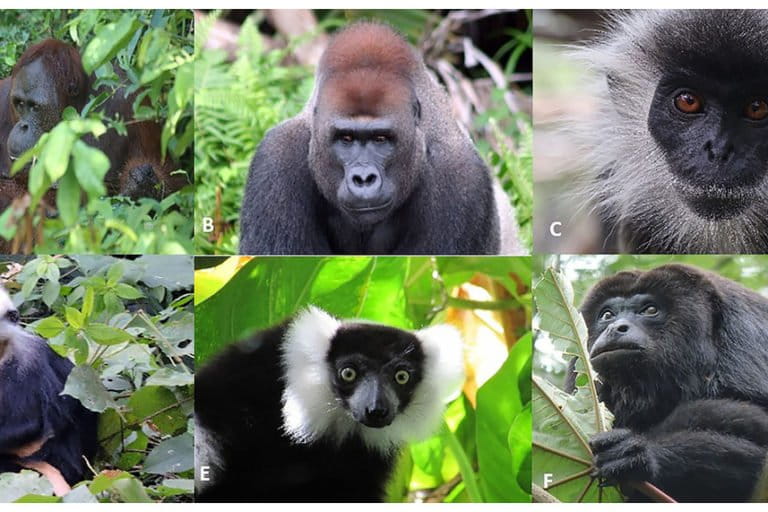- “Forest risk” commodities, such as beef, palm oil, and fossil fuels, led to a significant proportion of the 1.8 million square kilometers (695,000 square miles) of forest that was cleared between 2001 and 2017 — an area almost the size of Mexico.
- A previous study found that 60 percent of primates face extinction and 75 percent of species’ numbers are declining.
- The authors say that addressing the loss of primate habitat due to the production of commodities is possible, though it will require a global effort to “green” the international trade in these commodities.
The global trade of products that come at the expense of tropical forest is driving many primate species closer to extinction, a new study suggests.
The research, published June 17 in the journal PeerJ, found that the production or extraction of these “forest risk” commodities, such as beef, palm oil, and fossil fuels, led to a significant proportion of the 1.8 million square kilometers (695,000 square miles) of forest that was cleared between 2001 and 2017 — an area almost the size of Mexico.
“The consequences of [harvesting] these resources is that they result in the permanent deforestation and conversion of forested habitats into monocultures, pastures, degraded and polluted habitats,” Paul Garber, one of the paper’s co-authors and a primatologist at the University of Illinois, said in a video abstract. “If we look at the 15 primate-richest countries in the world, by the end of this century, if we don’t change business as usual, 80 to 100 percent of the primate species in those countries will be threatened with extinction or be extinct.”

In a previous study, Garber and his colleagues found that 60 percent of primate species worldwide are threatened with extinction and that 75 percent of species’ numbers are declining. For this research, the team compared those figures with surges in trade in regions where primates live and data on forest loss.
“There’s been an increase of about 300 percent across all of these four areas in commodities trade over the last 15 years,” Garber said. But, he added, the commodities driving the loss of forests, as well as the impacts that growing or extracting them had, vary from region to region.
In Southeast Asia, for example, the production of commodities like palm oil and rubber led to nearly half of all deforestation. In Mexico and Central and South America, soy and beef were responsible for about a quarter of forest loss.

South Asia had a similar amount of its deforestation — 26 percent — as a result of the push for commodities, though in that part of the world, fossil fuels and gemstone mining played the most significant roles. In Africa, 7 percent of deforestation occurred due to tradeable commodities, mainly the extraction of minerals and fossil fuels.
Nearly all of the demand for these goods came from just 10 countries, Garber said. Among the top importers of these goods are the United States, China, Japan and Switzerland; the U.S. and China were the destinations for 58 percent of these forest-risk exports.
Garber called primates the “canary in the coal mine,” and the authors say the places where these primates live need to be protected for their sakes as well as our own.

“Primates and their habitats are a vital component of the world’s natural heritage and culture,” Alejandro Estrada, the study’s first author and a primatologist at the National Autonomous University of Mexico, said in a statement. “[A]s our closest living biological relatives, nonhuman primates deserve our full attention, concern, and support for their conservation and survivorship.”
Garber added, “It comes at a great cost to the environment and people living in these primate habitat countries who are still relatively poor, food insecure, they have income inequality, and there’s still political instability in these countries.”
The authors say the international community needs to come together through a set of international agreements to overhaul how these products — which end up in supermarkets, gas stations and shops in consumer countries — are harvested, arguing that we must trade “green.”

“What we mean by that is that the cost of a product needs to include the environmental cost of production,” Garber said, “and then those funds need to [be] put into an international fund that can be used to try to mitigate some of the problems.”
Without such global action, the team writes, more species will continue to fall under the specter of the threat of extinction or be wiped out entirely.
“We have a window of time to change our behavior, but that requires leadership and a set of people worldwide who can help direct this effort,” Garber said. “It cannot be done by any one country. It’s not the fault of any one country. But we need international agreements to move this forward.”
Banner image of a ring-tailed lemur by Rhett A. Butler/Mongabay.
Citations:
Estrada, A., Garber, P. A., & Chaudhary, A. (2019). Expanding global commodities trade and consumption place the world’s primates at risk of extinction. PeerJ, 7, e7068. doi:10.7717/peerj.7068
Estrada, A., Garber, P. A., Rylands, A. B., Roos, C., Fernandez-Duque, E., Di Fiore, A., … & Rovero, F. (2017). Impending extinction crisis of the world’s primates: Why primates matter. Science advances, 3(1), e1600946. doi:10.1126/sciadv.1600946
FEEDBACK: Use this form to send a message to the author of this post. If you want to post a public comment, you can do that at the bottom of the page.














